Friends, I garden not only for the beauty and abundance, not just for the smell of fresh lavender or the satisfaction of good, hard work.
I garden to be in awe of the world.
Today, lacewings are the embodiment of such awe for me.
What is a lacewing?
Chrysopa carnea (there’s a clue!) is one of our finest beneficial insects native to the Northeast, very likely the most voracious insect in your garden. For breakfast, lunch and dinner they dine on your aphids, thrips and cabbage looper caterpillars. Here’s our…
4 Reasons to Love Lacewings in Organic Gardening
1. An Unmistakable Appetite for Aphids
Adult lacewings are darling with their sweet lime green bodies, sparkling gold compound eyes and dramatic, sweeping wings like exquisite, translucent stained glass. Adult lacewings feed on nectar, pollen and the honeydew of aphids, like ants.
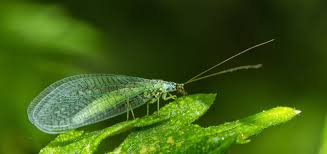
Lacewing adults are gorgeous as well as nocturnal, so they’re rare to see. Photo courtesy of Wikipedia.
Their larvae, by contrast, are exclusively and unmistakably predatory, enjoying up to 600 aphids before they pupate. Like an inch-long dinosaur equipped with claws and piercing, sucking mouthparts, I literally shiver when I see them. Part of their jaw is hollow, allowing them to inject a digestive secretion into their pray which dissolves the organs of an aphid in 90 seconds.
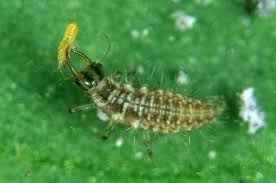
Ravenous lacewing larvae are still intimidating to look at, even less than an inch long. Photo courtesy of Wikipedia.
Lacewing larvae indiscriminately devour the soft, small bodies of insects, though they have a particular appetite for aphids. They additionally dine on spider mites (especially red mites), thrips, whiteflies, eggs of leafhoppers, leafminers, and small caterpillars as well as beetle larvae. Lacewings reduce these populations on most plants, except those that are notably hairy, like tithonia, or sticky, like calendula. After two to three weeks, each larva will pupate for two weeks in the soil before emerging as adults to lay eggs and continue the cycle.
2. Crazy Voracious: Just look at their eggs
Lacewing larvae are so fixated on devouring copious quantities of small, soft-bodied insects that they, given the chance, will cannibalize their siblings’ eggs the moment they hatch. This is why each egg is laid upon a slender, one-centimeter filament, encouraging each voracious hatchling to trundle past its siblings.
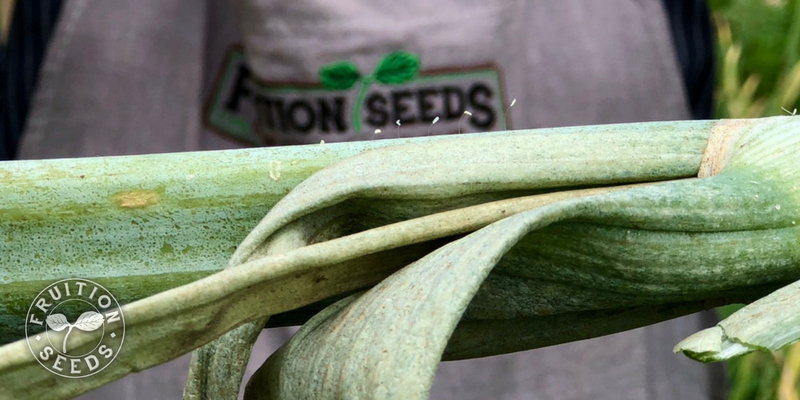
Lacewing eggs are easily identified by the centimeter-long filament suspending each one in the air.
Finding these luminous white eggs suspended above our vegetables absolutely makes my day, every time. In early July I begin to find them all over the garden, on vegetables and flowers alike. Each female lays several hundred eggs in her four-week lifetime, often in clusters of 6 to 20, frequently in proximity to a burgeoning aphid population where they hatch in three to six days.
3. Adept Evasion Adaptation
It’s rare to see adult lacewings, as gorgeous as they are, since their nocturnal tendencies send them out to hunt under the stars each night. In general, there are fewer predators for insects flying at night, though bats are quite fond of soft, protein-rich lacewing adults.
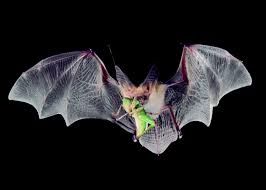
Lacewings have developed extraordinary evasion tools to defy bats, their primary predators. Photo courtesy of Wikipedia.
Remarkably, lacewings have extraordinary ‘tymphanal organs,’ allowing them to evade bats by detecting and responding to their ultrasound ‘echolocation’ communication. When a lacewing hears bat echolocation calls in flight, their wings close, reducing their echolocational signature, and they drop to the ground.
4. Grow Flowers and Lacewings Will Come
Adult lacewings predominately eat nectar and pollen from flowers, so if you grow flowers, you are abundantly attracting adult lacewings.
Lacewing adults are attracted to the nectar-rich Asteraceae family, especially native coreopsis and sunflower as well cosmos and the Apiaceae family in flower, particularly dill.
Lacewing adults seek the nourishment of nectar and pollen, especially from flowers in the Asteraceae family, such as this Lemon Queen sunflower.
Adult lacewings overwinter as adults in leaf litter on the edges of gardens, meadows and forests. They’re widespread and common though inconspicuous, so they’re easy to miss. The adults will often disperse once they pupate, so providing abundant blooms throughout the season will entice them to stay, creating the next generation of ravenous larvae to keep your aphids in check.
Friends, countless insects surround us each day, making possible this world we all call home.
Cultivate your beneficial insects as well as your tomatoes.
As if our lives depend on it, let us joyfully cultivate the curiosity that creates care and connection.
Awe and abundance, intrigue and observation: these, perhaps, are the greatest gifts of the organic garden.
Sow Seeds & Sing Songs,

and the Many Beings of Fruition
ps
For more on all the ways we are better together including in our gardens, enjoy Fruition’s Guide to Companion Planting!
pps
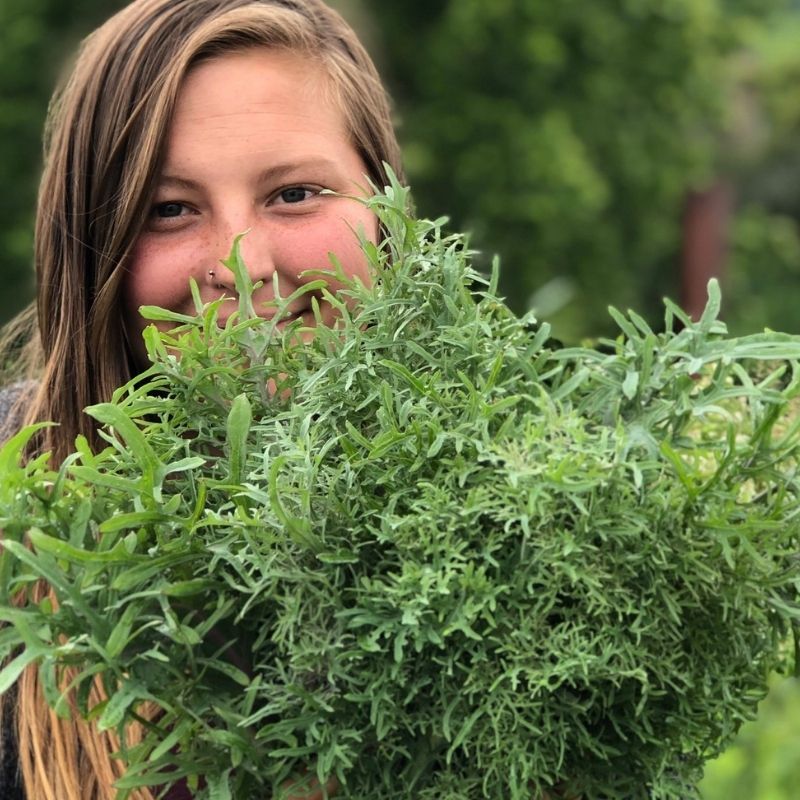
Join the
Fruition Family!
Our weekly organic gardening emails share seasonal inspiration as well as insight
~When you join us, check your inbox for your welcome & access info! Stay tuned for our weekly organic gardening tips & inspiration, as well~

